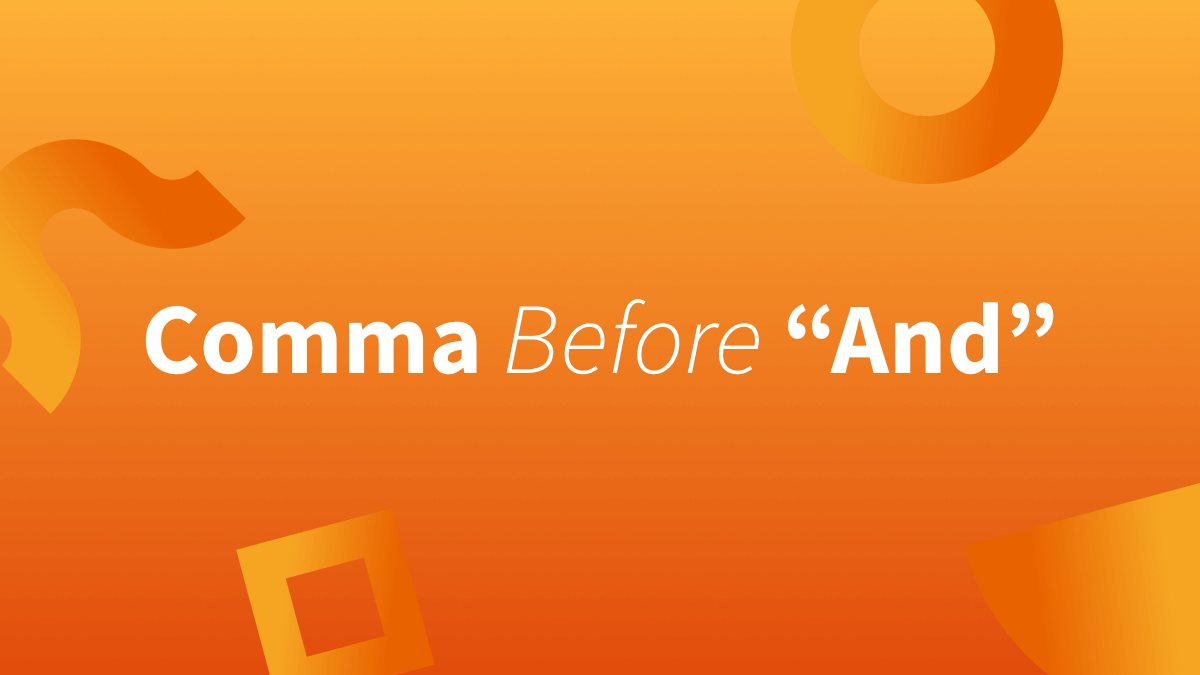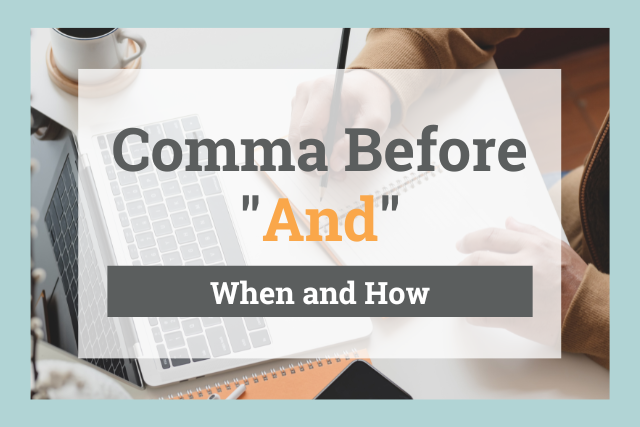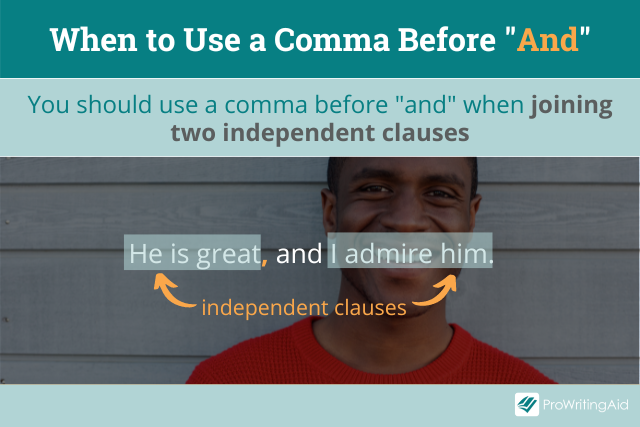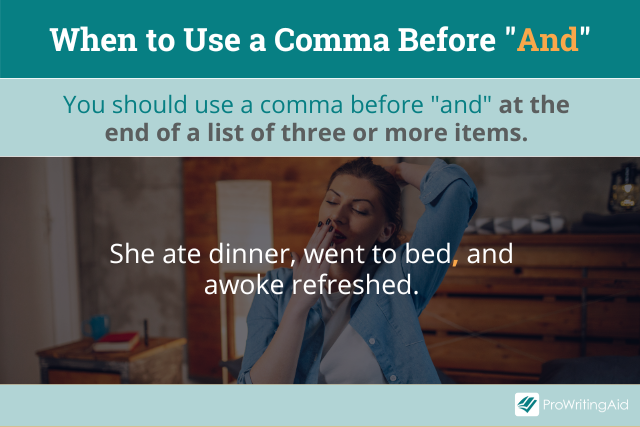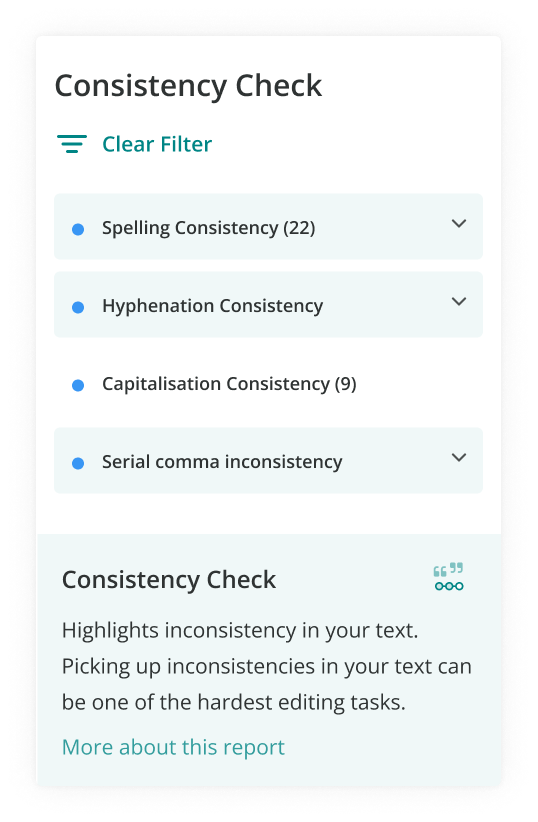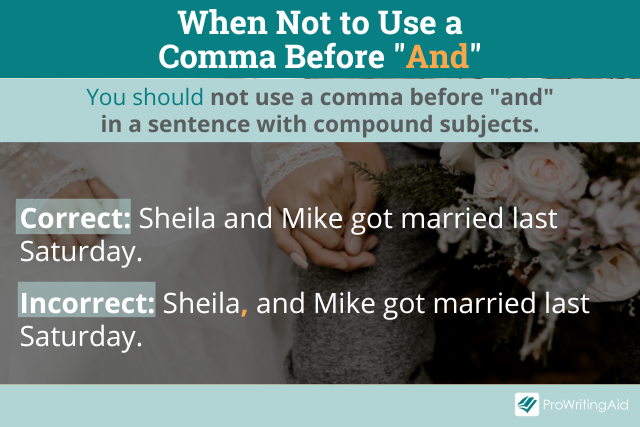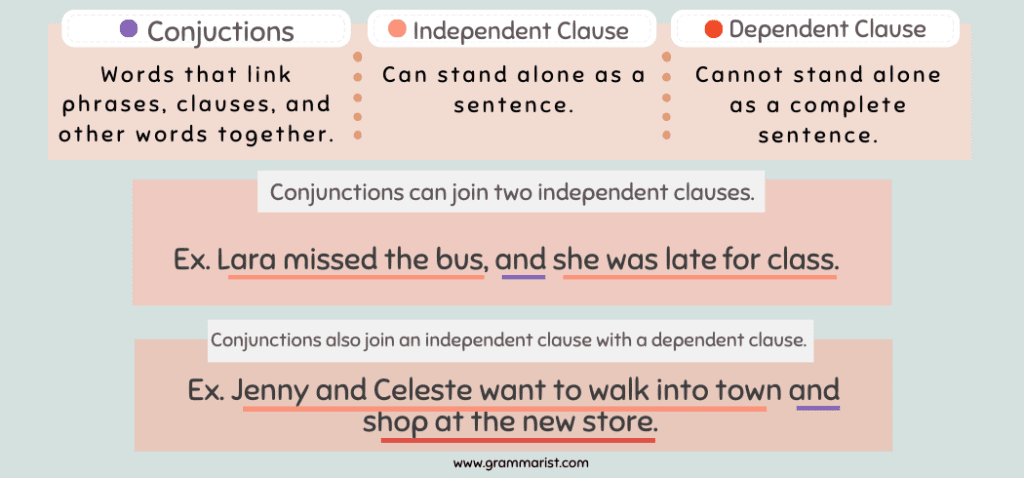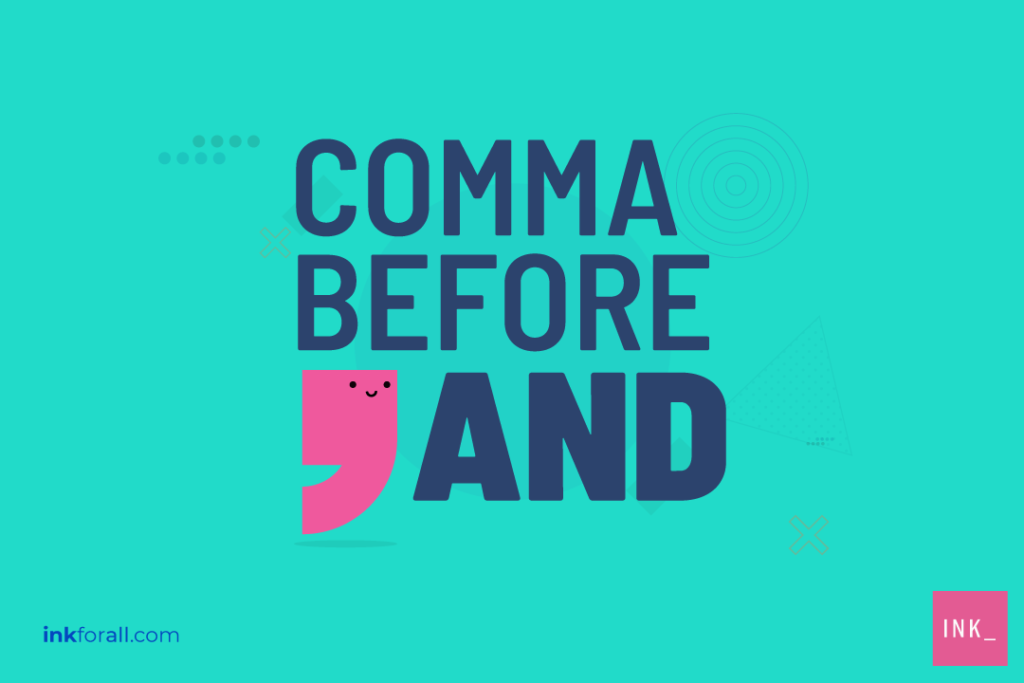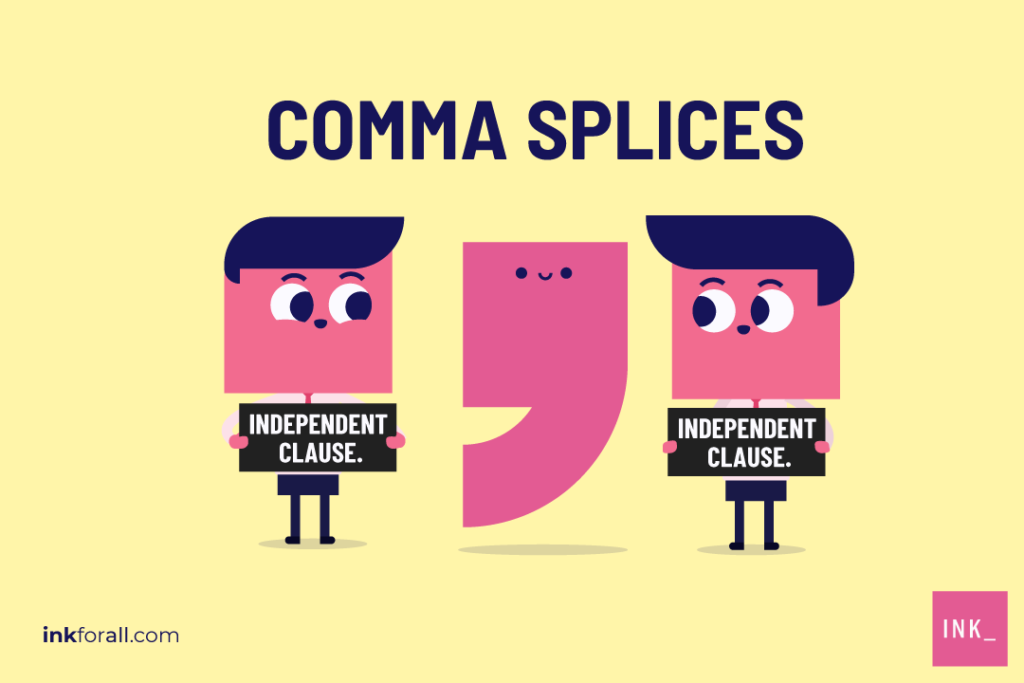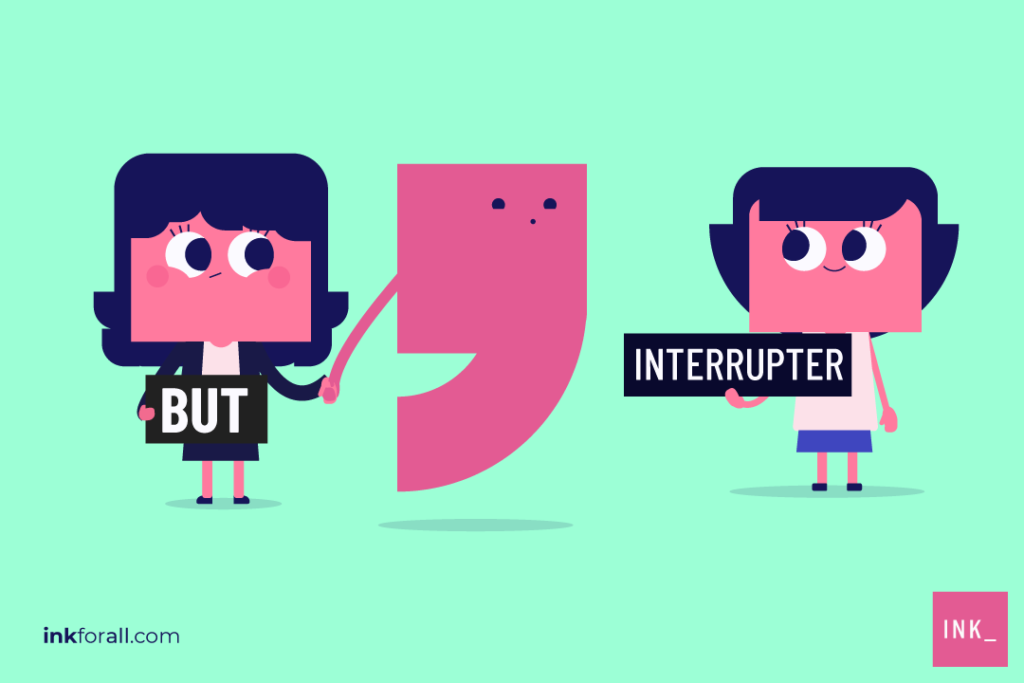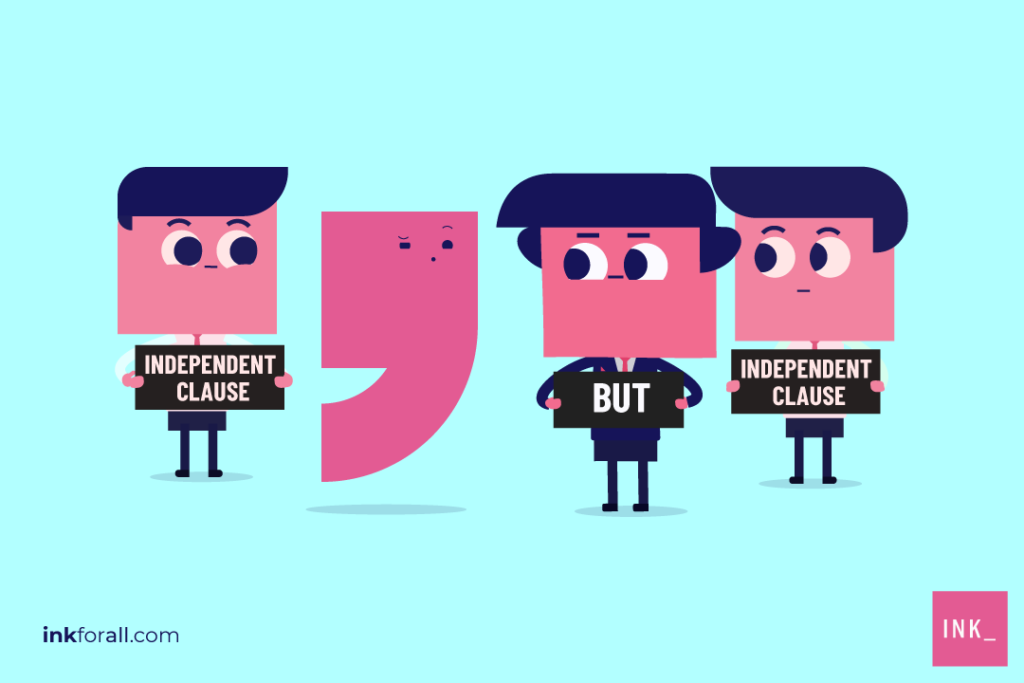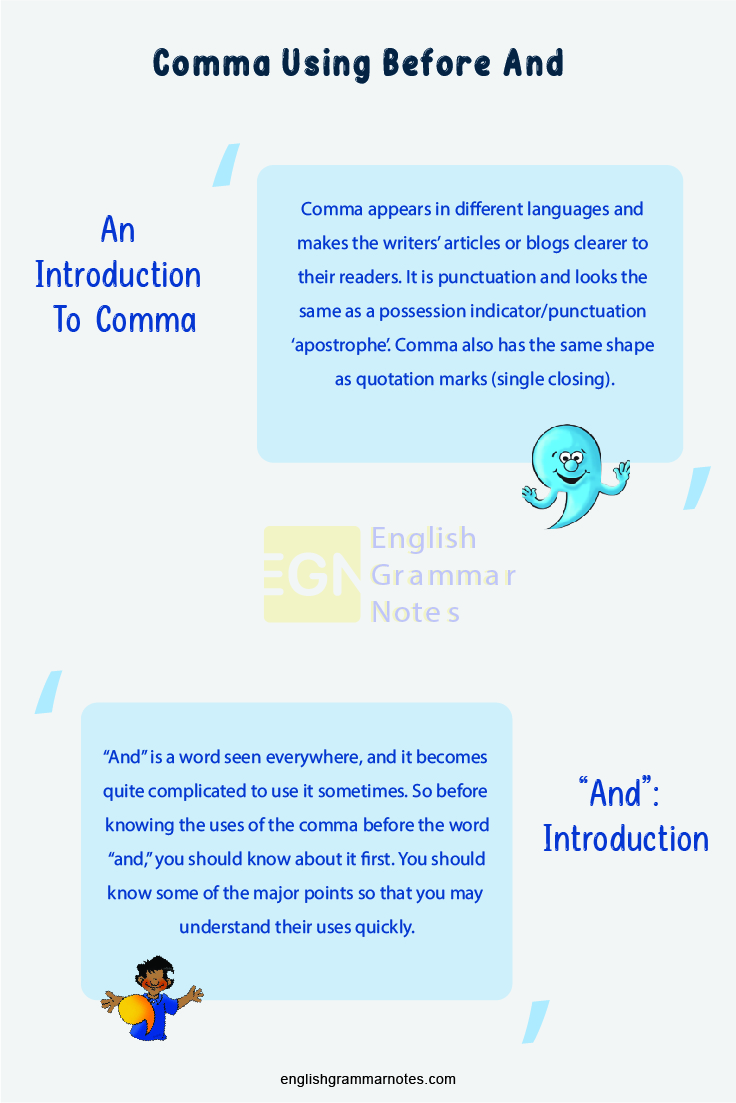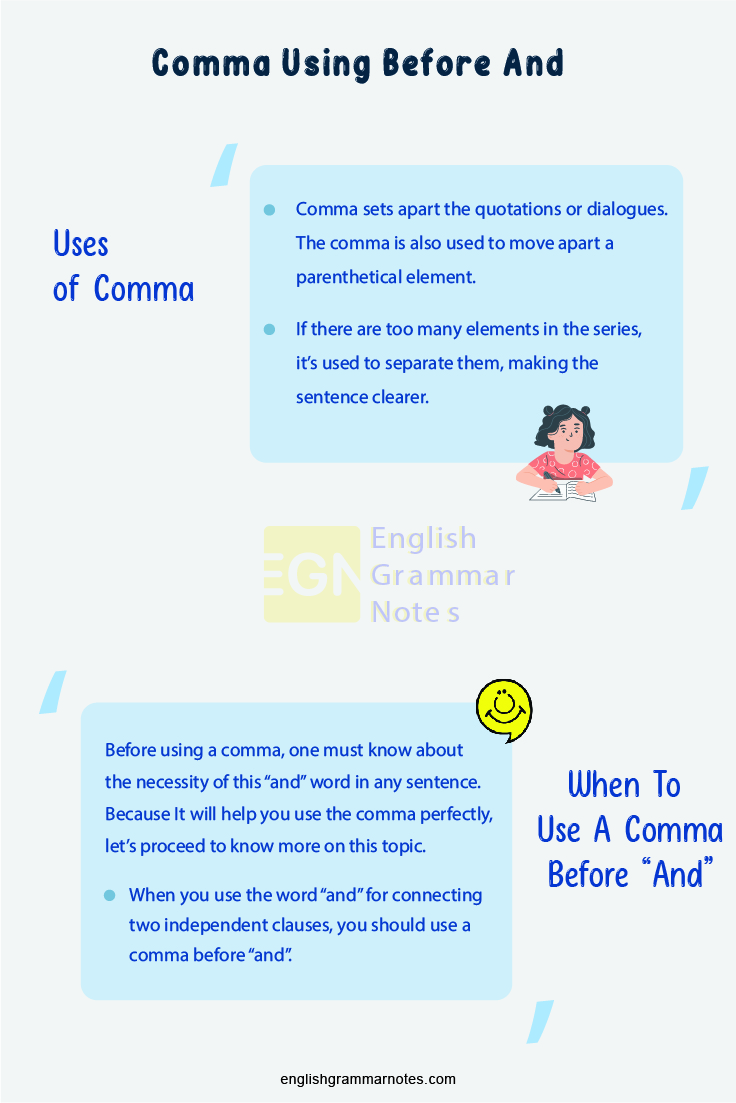Does a Comma Always Precede “And”?
powered by
LanguageTool
There are a few comma guidelines to keep in mind while writing. This blog post will discuss commas and the conjunction “and.”
- A comma signals a pause between parts of a sentence.
- When writing a list of three or more, the use of an Oxford comma before and is optional, but often recommended.
- When and connects two independent clauses, a comma should be placed before it.
- The only time a comma isn’t required before and is if the two independent clauses are short and closely related or when a list contains only two entities.
✅ They visited Portugal, Spain, and France.
✅ They visited Portugal, Spain and France.
✅ Catalina stayed with her uncle, and her cousin Ramon stayed with his cousin.
✅ Carlos danced and Felipe sang.
✅ I like bananas and pears.
Is a Comma Before “And” Necessary?
A comma is a punctuation mark that indicates a slight pause between different parts of a sentence. In writing, it helps readers differentiate the clauses. There are many guidelines to keep in mind when deciding whether to use a comma. Below, we’ll focus and elaborate on when to use a comma before the conjunction and.
A conjunction is a word that connects words, phrases, and clauses to each other. And is a type of coordinating conjunction (along with for, nor, but, or, yet, and so). Another term you should be familiar with to understand when you should (or shouldn’t) use a comma before and is independent clauses. These are clauses that can stand on their own as grammatically complete sentences. When the conjunction and connects two independent clauses, then a comma is required. For example:
Isaac went to the supermarket to buy food, and then he passed by his dad’s house to have dinner.
In the example above, the two clauses that can stand on their own are:
- Isaac went to the supermarket to buy food.
- Then he passed by his dad’s house to have dinner.
Because they can stand on their own as complete sentences, a comma should be placed before the conjunction and. Here’s another example:
Shawna had to drive all the way back to her house, and Geoffrey had to drop off her cat at the vet.
Shawna had to drive all the way back to her house and Geoffrey had to drop off her cat at the vet.
However, if two independent clauses are short and closely related, then a comma before and isn’t needed. It’s a stylistic choice that’s left up to the writer.
I swept and Thomas mopped.
I swept, and Thomas mopped.
But if and connects an independent clause to a dependent clause, then you shouldn’t add a comma.
My hamster is cute and eats a lot.
My hamster is cute, and eats a lot.
How About Commas Before “And” in Lists?
There are two schools of thought when it comes to using a comma before and in a list: you either love them or hate them. This comma is known as the Oxford, Harvard, or serial comma.
Here’s an example of an Oxford comma before and:
Eduard enjoyed reading about biology, astronomy, and chemistry.
And here is the same sentence without the comma before and:
Eduard enjoyed reading about biology, astronomy and chemistry.
Different publications have their own guidelines when it comes to whether a comma has to precede the conjunction and. If you’re not sure, just ask. If you’re writing for yourself, stay consistent; pick a style and stick with it.
It’s important to note that a list with only two items (or any other type of words) does not require a comma.
She ate pasta and garlic rolls.
She ate pasta, and garlic rolls.
Commas significantly improve the flow of your writing. The rules mentioned above are just some of the many to remember. If you want to make sure you are always using commas correctly, try out LanguageTool. As a writing assistant, LanguageTool detects missing commas and suggests where you can add them. As if that weren’t helpful enough, this text editor can also correct spelling mistakes and grammar errors in more than twenty languages!
Unleash the Professional Writer in You With LanguageTool
Go well beyond grammar and spell checking. Impress with clear, precise, and stylistically flawless writing instead.
Get started for free
We Value Your Feedback
We’ve made a mistake, forgotten about an important detail, or haven’t managed to get the point across? Let’s help each other to perfect our writing.
Like many English comma rules, whether or not you use a comma before «and» depends on the situation. There are two instances when you should use a comma before «and.»
First, use a comma when «and» joins two independent clauses. You can also use a comma when «and» precedes the last item in a list. This is called an Oxford comma.
Today, we’re taking a closer look at the rules about using a comma before «and» in sentences.
If your comma skills are rusty, you can always use ProWritingAid’s free grammar checker to find all your misplaced and missing commas.
Do You Put a Comma Before «And»?
There are two main instances when you should put a comma before «and» in a sentence. Let’s dive into each rule in more detail.
Comma Before «And» When Joining Independent Clauses
To understand how to use a comma before «and,» you need to understand the difference between independent clauses and dependent clauses.
An independent clause is a statement that can stand alone as a complete sentence. Independent clauses always have a subject, a verb, and express a complete thought.
A dependent clause is a statement that cannot stand alone as a complete sentence. It may have a subject and a verb, but it is an incomplete thought.
Coordinating conjunctions can link two independent clauses. The seven coordinating conjunctions are: for, and, nor, but, or, yet, so.
When «and» combines two independent clauses, you should use a comma before “and.” This rule applies to any coordinating conjunction that joins two independent clauses.
Correct: He is great, and I admire him.
Incorrect: He is great and I admire him.
Both clauses can stand alone as a complete sentence. We could say, «He is great. I admire him.» We used «and» to join the independent clauses, so we put a comma before «and.»
It’s important to note that you should only use a comma to join independent clauses if a coordinating conjunction like «and» is present.
If you combine two independent clauses with just a comma and no conjunction (e.g. He is great, I admire him.), this is called a comma splice. It’s grammatically incorrect.
Comma Before «And» in a List
The other situation where you should place a comma before «and» in a sentence is in a list. The Oxford comma, also called a serial comma, precedes «and» before the last item in a list.
To use an Oxford comma, there should be three or more items in a list. If there are only two items, you do not need a serial comma before «and.»
Correct: She ate dinner, slept all night, and awoke refreshed.
Incorrect: She ate dinner, and awoke refreshed.
The Oxford comma is grammatically correct, but it is not required. It used to be more common not to use it, but it’s become the preferred comma usage.
If you prefer to write a list without the Oxford comma, that’s fine. However, you should check any style guides if you’re doing business or technical writing.
The important thing is to be consistent with your serial comma usage. Don’t use the Oxford comma part of the time and leave it out the rest.
ProWritingAid’s Consistency Report will help make sure you are sticking with one rule or the other.
Comma Before «And More»
You can also use an Oxford comma before «and more» if your list ends with this phrase. In these situations, «more» acts as the last item in a list.
Let’s look at an example of how this might look.
- The rehearsal dinner included tacos, enchiladas, elote, frijoles charros, and more.
However, the comma before «and» is optional because it is a serial comma.
Do You Put a Comma After «And»?
If you use a comma with «and,» it should always precede the word «and.» You should never put a comma after the word «and.»
This rule applies to both independent clauses joined by «and» and lists of three or more items, as well as any other time «and» might appear in a sentence.
It also applies to all other coordinating conjunctions; you should never put a comma after a coordinating conjunction.
Correct: We met for lunch, and we spent two hours chatting at the restaurant.
Incorrect: We met for lunch and, we spent two hours chatting at the restaurant.
Correct: My pets include two rats, three hamsters, and a ferret.
Incorrect: My pets include two rats, three hamsters and, a ferret.
Remember, commas can precede «and» but can’t follow it.
When Shouldn’t You Use a Comma Before «And»?
You should only use a comma before «and» in a list or when joining two independent clauses.
«And» sometimes joins an independent clause with a phrase that isn’t a complete thought. This incomplete thought usually takes the form of either a compound subject or a compound predicate.
When this happens, do not use a comma before «and.»
Here’s an example of «and» in a compound subject:
Correct: Sheila and Mike got married last Saturday.
Incorrect: Sheila, and Mike got married last Saturday.
Sheila and Mike are both subjects, so this is a compound subject. No comma is required.
Now, let’s look at an example of a compound predicate that uses «and.»
Correct: The baby drank a bottle and went to sleep.
Incorrect: The baby drank a bottle, and went to sleep.
In this example, «went to sleep» is not a complete thought. There’s no subject, so it’s not an independent clause and therefore does not require a comma.
Examples of Comma Before «And» in Sentences
Here are a few more examples of how to use a comma before «and» in a sentence.
- A librarian can recommend a good book, and they can also help you with research.
- Lavender plants smell great, and they also repel mosquitos.
- After work, I went to the grocery store, the post office, and the gas station.
- Christy got gift cards, a bottle of wine, bath bombs, and new shoes for her birthday.
Comma rules can be tricky because there are so many scenarios where we need this versatile punctuation mark.
Just remember that you should only put a comma before «and» when joining two independent clauses or in a list of three or more things.
Take your writing to the next level:
20 Editing Tips From Professional Writers
Whether you are writing a novel, essay, article, or email, good writing is an essential part of communicating your ideas.
This guide contains the 20 most important writing tips and techniques from a wide range of professional writers.

Commas are probably one of the most confusing punctuation marks to use, and even I struggle to find ways to help my students determine where they belong.
One of the most commonly asked questions I hear surrounds whether to place a comma before or after the word “and.” Unfortunately, the answer is not quick or simple. However, the comma rules concerning the word “and” is not difficult to understand.
I’m going to start simple and explain how the word “and” is used and then provide rules on punctuation surrounding comma usage so you can understand where they belong together. I’ve also provided plenty of examples below.
Common Coordinating Conjunctions and Compound Sentences
Conjunctions are words that link phrases, clauses, and other words together. They allow you to form compound-complex sentences to enhance the flow of your writing and speech.
Coordinating conjunctions include the words for, and, nor, but, or, yet, and so. The guide to comma usage in relation to conjunction use are the same for all of them, but the word “and” is more used than any other choice.
Conjunctions can join two independent clauses or clauses that could work as stand-alone sentences.
For example, the following two independent clauses:
- Lara missed the bus. She was late for class.
Becomes
- Lara missed the bus, and she was late for class.
Conjunctions also join an independent clause with a dependent clause or clause that cannot stand alone as a complete sentence.
For example:
- Lara needs to start getting to class on time and make sure her homework is complete.
Rules of Comma Usage
There are six basic rules of comma use, but I find it is much easier to teach each rule independently of one another with plenty of examples. Such is the case with commas and conjunctions.
Using “And” to Join Two Independent Clauses: Comma BEFORE “And”
When “and” joins together two independent clauses, a comma needs to be placed before the “and.” Independent clauses are complete sentences, but their conjoining makes a complex-compound sentence. The comma works to indicate this use.
For example:
- I hate having to get up early for work, and getting chores done at that time of the morning is exhausting.
- It hasn’t rained in our town or the surrounding areas, and the lack of rain is starting to make everyone very anxious.
- I’m so glad the end of the week is nearing, and I can’t wait until I can sleep in this weekend.
Using “And” with a Dependent Clause: No Comma
If you are joining together an independent clause with a dependent clause, you do not use a comma.
For example:
- Jenny and Celeste want to walk into town and shop at the new store.
- Wyatt wanted to study Marine Biology and go to a summer camp for more experience.
- Sarah got in big trouble at school for fighting and was suspended for ten days.
Using “And” with Short Independent Clauses: No Comma
Even though they are technically independent, it is acceptable to avoid the comma for shorter sentences.
For example:
- Emmett likes trains and Emily likes horses.
- Mary likes math and John likes writing.
- Javier likes football and Mark likes lacrosse.
Using “And” with List Items:
Depending on how many items you have to list determines whether you use commas in lists with the “and.” There are also multiple ways to approach whether you use a comma or not, which can cause quite a bit of confusion.
Take a look at the examples below to determine which approach works best for you.
Two Items: No Comma
When listing two items, you do not use a comma before the “and.”
For example:
- I need to run to the store for milk and butter.
- She couldn’t decide between art and choir.
- He played in the band and played football.
Three or More Items: Serial Comma BEFORE “And”
The use of a comma before the word “and” when listing three or more items has been a topic of hot debate for many years. This quirk of comma usage is called a serial comma – a comma used in a series of items. It is also called the Oxford comma.
The Oxford comma’s rules state that a comma belongs between the last two items in a series of three or more items to avoid ambiguity. The serial comma controversy is addressed in the the AP Style Guide stating the Oxford comma is grammatically incorrect. But, linguists everywhere will agree it is a grammatical option.
In fact, there has been a lawsuit about a job description that offered two different interpretations of an exception rule: in this case, whether overtime was owed. The judge ruled an Oxford comma was required to include the last item in the list concerning exception, but since it was not used, the item was not part of the list, and overtime was indeed owed.
I also teach the Oxford comma in order to ensure clarity and avoid confusion. Without it, some pretty amusing situations can occur.
For example:
- Rachel finds inspiration in cooking, her dog and family.
- We went to the concert with neighborhood friends, Grandma and Grandpa.
The first sentence sounds like Rachel cooks her dog and her family. In the second sentence, it sounds like the neighborhood friends are named grandma and grandpa.
Instead of accidentally creating this confusion, simply use an Oxford comma to create clarity.
For example:
- Rachel finds inspiration in cooking, her dog, and her family.
- We went to the concert with neighborhood friends, Grandma, and Grandpa.
When to Use Commas AFTER “And”
A comma is almost never used after the word “and.” However, there are a few exceptions. In general, do not place a comma after “and” unless the following is true:
“And” is Used to Introduce a Parenthetical Expression
A parenthetical expression is a non-essential phrase that is offset from the main sentence to add detail or information.
For example:
- I have to drive to Texas every two weeks for a doctor’s appointment, and, if I’m lucky, I have extra time to do a little shopping.
“And” is Used in a Line of Dialog
Written dialog may require a comma following an “and” depending on the style and tone the author is trying to create with a character.
For example:
- “And,” Michael dictated, “you have to be up two hours before daybreak if you want to get there on time.”
Let’s Review
A comma is almost never used after the word “and,” barring a few exceptions, but it is commonly used before when you combine two complete sentences into a compound sentence or when listing more than two items.
It is important to use commas properly to avoid overuse and help ensure writing clarity. Like I tell my students, when you look at one grammar rule at a time and practice its application, you will almost always remember its use.
Certain grammatical situations require the use of a comma beforeand. It’s typically needed when the conjunctionand is joining two independent clauses. Or if you’re using it in lists that require an Oxford comma.
This brief guide will shed light on the age-old question of whether to use a comma before the word and.
Main Comma Before And Takeaways:
- A comma is a form of punctuation that indicates a pause in a sentence and separates items in a list.
- Commas should be used before and when joining two independent clauses or when compiling a list.
- Commas can separate adjectives, offset nonessential phrases, and introduce direct quotations.
- Oxford commas are also known as serial or Harvard commas.
- Serial commas are used after the next-to-last item in a list and before the and.
- The AP Stylebook doesn’t advocate the use of the Oxford comma.
Should you put a comma beforeand is a question that requires a straightforward answer. Either you do, or you don’t, right?
Is There a Comma Before the Word and?
Unfortunately, the answer isn’t entirely so black and white. When to use a comma beforeand in a sentence depends on several factors:
- Whether the and is linking two independent clauses
- If the and is separating items in a list or series
- Whether you’re using an Oxford (or serial) comma
- If a pause is necessary
- What style guide you’re following
What is the Comma Before And Called?
The answer to that depends on how you’re using the word and. In general terms, a comma falls under the category of a punctuation mark. It’s often used to indicate a pause in a sentence or to separate items in a list. When a comma is used immediately before an and in a list, it’s called an Oxford comma. Others may refer to the comma before and as a serial or Harvard comma.
What are the 8 Commas Rules?
Whether it comes before and or elsewhere in a sentence, following basic comma rules can make using this misunderstood punctuation mark a breeze. In a nutshell, we use commas to:
- list items,
- separate adjectives,
- join independent clauses,
- offset introductory and nonessential phrases,
- introduce quotations, and
- maintain flow.
Whew! Take a breath. Let’s take a closer look at each of these rules.
Rule 1: Use a Comma in a Series or List
When creating a list of three or more simple words, items, or concepts, use a comma to separate each word or word group.
Note: Using a comma after the next-to-last item in a list is a stylistic choice and may depend on the style guide you’re following.
Rule 2: Separate Adjectives With a Comma
When you use more than one adjective to modify a noun or pronoun, use commas to separate them. This is only true if the adjectives’ order is interchangeable.
Note: This could easily read: She had a healthy, happy baby.
Rule 3: Use a Comma When Joining Two Independent Clauses
When a conjunction (for example: and, or, and but) links two independent clauses, you need to put a comma before the conjunction.
Note: An independent clause must have a subject and verb. It should express a complete thought.
Rule 4: If a Sentence Begins With a Dependent Clause, Use a Comma After It
If a sentence begins with an introductory phrase or dependent clause, it should have a comma immediately after it.
Rule 5: Offset Nonessential Words, Phrases, or Clauses With Commas
If a sentence contains nonessential words, phrases, or clauses, use commas to set them apart. These nonessential sections often begin with words such as who or which. They may be removed from a sentence without altering its meaning.
Rule 6: Commas Introduce Direct Quotations
Direct quotations, such as dialogue, should be preceded by commas.
Commas may also be used to express interruptions to direct quotations.
Rule 7: Commas Set Off Phrases That Interfere With Sentence Flow
Commas can be used to set apart phrases that interrupt the flow of a sentence. These may include expressions such as by the way, after all, and nevertheless.
Rule 8: Commas Set Off Names, Nicknames, and Titles
When directly addressing a person, use a comma to set off their name, nickname, title, or term of endearment.
Do You Use a Comma Before “And” When Joining Two Sentences?
Yes. When joining two independent clauses or sentences, “and” acts as a coordinating conjunction. The rule states that a comma must be used before a conjunction when it’s joining two independent clauses or sentences. This rule is applicable to other coordinating conjunctions like but, so, and or, to name a few.
Commas Before And: An Overview
Commas BeforeAnd are used primarily in two specific situations:
1. Joining Independent Clauses With a Conjunction
An independent clause is a phrase that expresses a complete thought. It must have both a subject and a verb. In other words, it can stand alone as a sentence.
A sentence can contain two independent clauses if they’re linked by a conjunction such as and, or, and but. (Without the conjunction, two independent clauses typically form a run-on sentence). A comma is required after the final word of the first clause, before and (or whatever conjunction you’re using).
Take these two independent clauses:
If you join them together with only a comma, they form a comma splice.
If you add an and after the comma, the sentence becomes grammatically correct.
Exceptions to the rule:
If the two independent clauses are short and have a strong connection, then the comma should be omitted. Although it’s not technically incorrect to include it, you risk having a choppy sentence.
2. Before the Next-To-Last Item in a List
Commas are almost always used to separate items in a list or series that contains three or more things. More specifically, some lists contain a comma that’s known as the Oxford comma. This punctuation sits immediately after the list’s next-to-last item, just before the and or the or.
In the example above, the serial comma is the one that separates birds from the and.
Exceptions to the Rule: In simple lists, a comma beforeand isn’t always necessary and doesn’t actually enhance a sentence. Sometimes, the omission of this serial comma is even advisable.
In fact, the Oxford comma is a hotly debated point in modern grammar, and ultimately, it comes down to a stylistic choice.
Certain style guides, such as the AP Stylebook, don’t advocate using this serial comma unless it’s absolutely necessary for preserving a sentence’s meaning.
Comma Confusion: Final Thoughts
Let’s face it. Commas can be confusing. They’re also important. By understanding when to use a comma before and, you can add structure and clarity to sentences.
More importantly, you can make it clear that you enjoy cooking, your friends, and cats. And that no, you don’t enjoy cooking your friends and cats.
Quick Comma Before and Quiz
Comma Before And Question #1
A. When joining two independent clauses
B. In a series or list
C. To introduce direct quotations
D. All of the above
Correct!
Wrong!
The answer is D. Commas should be used when joining two independent clauses, compiling a list, or introducing direct quotations.
Comma Before And Question #2
A. Oxford comma
B. Serial comma
C. Cambridge comma
D. Harvard Comma
Correct!
Wrong!
The answer is C. The Oxford comma comes immediately before an «and» in a list. Others refer to it as a serial comma or Harvard comma.
Comma Before And Question #3
A. AP stylebook
B. The MLA handbook
C. The Chicago Manual of Style
D. The Elements of Style
Correct!
Wrong!
The answer is A. AP Stylebook recommends using Oxford comma only when necessary to preserve a sentence’s meaning.
Comma Before And Question #4
A. His bright, yellow coat was stolen.
B. His bright yellow coat was stolen.
Correct!
Wrong!
The answer is B. You can separate adjectives with a comma only when the adjectives’ order is interchangeable.
Comma Before And Question #5
Correct!
Wrong!
The answer is TRUE. An independent clause can stand alone.
Comma Before And Question #6
A. Jack loves video games and he enjoys playing board games.
B. Jack loves video games, and he enjoys playing board games.
Correct!
Wrong!
The answer is B. Use a comma after the final word of the first clause, before “and.”
Read More: When To Use Comma Before Such As: The Definitive Guide
When there are two items in a list, you should not use a comma before and. If the list has three or more items, the use of comma is optiona.
In a list of just two items, do not use a comma before “and”.
I need to buy apples and oranges.
I need to buy apples, and oranges.
In a list of three or more items, the comma before “and” is optional.
I need to buy apples, oranges, and lemons.
When joining two independent clauses (both parts of the sentence contain a subject and a verb), add a comma before “and”.
I went to the movies, and my brother decided to stay home.
I went to the movies and my brother decided to stay home.
If the subject does not appear in front of the second verb, the comma is generally unnecessary.
I need to wash the dishes and take out the trash.
Exceptions? Always use a comma to clarify (avoid confusion).
Contents
- 1. Comma Before ‘And’ in a List
- 1.1 Lists of Two Items
- 1.2 Lists of Three or More Items
- 2. Using a Comma to Separate Clauses and Phrases
- 2.1 Add a Comma Before ‘And’ to Join Two Independent Clauses
- 2.2 You Can Omit the Comma If the Subject Is Not in Front of the Second Verb
1. Comma Before ‘And’ in a List
1.1 Lists of Two Items
Do not use a comma before “and” if a list contains two items or groups of words:
They like watching dolphins and whales
They like watching dolphins, and whales
I hate doing laundry and cleaning bathrooms.
I hate doing laundry, and cleaning bathrooms.
A list can contain longer groups of words. In such a situation, you can add a comma to clarify so that the reader can spot the two elements more easily. For example:
England and Denmark and Italy and Spain will play for a place in the final.
England and Denmark, and Italy and Spain will play for a place in the final.
Three more examples where no comma is required:
I love cats and dogs.
My sister is very intelligent and competent.
High and increasing public debts are only sustainable in a low-interest rate environment.
1.2 Lists of Three or More Items
Using a comma before “and” in a list of three or more items is often optional.
I had bacon, eggs, and a cup of coffee.
I had bacon, eggs and a cup of coffee.
This comma is known as the Oxford comma or serial comma. Many fiction and nonfiction authors prefer the Oxford comma.
The young man loves watching dolphins, seahorses, and whales.
By contrast, a wide range of magazines and newspapers tend to omit it.
The suspect went to the mall, ate at the food court and went home.
It is a stylistic choice whether to use the Oxford comma. However, it is important to be consistent and avoid switching back and forth, except when the omission of the Oxford comma could cause uncertainty or confusion
The ingredients of my recipe are eggs, chocolate and peanut butter and sugar.
The ingredients of my recipe are eggs, chocolate and peanut butter, and sugar.
The comma after «butter» makes clear that «chocolate and peanut butter» represents a unit (a previously prepared ingredient).
2. Using a Comma to Separate Clauses and Phrases
2.1 Add a Comma Before ‘And’ to Join Two Independent Clauses
An independent clause is a group of related words that can form a complete sentence standing alone and contains a subject and a verb.
My father plays the piano, and my mother plays the guitar.
The sentence above has two clauses:
- «My father plays the piano.»
- «My mother plays the guitar.»
They are independent clauses; both contain a subject and a verb and express a complete thought.
When two independent clauses are joined by “and”, put a comma at the end of the first clause.
Olivia has tasted the soup, and she’s not happy with it.
Olivia has tasted the soup and she’s not happy with it.
Exceptions? If both clauses are very short, it is acceptable to omit the comma.
Mary writes and John reads.
More examples:
Where are they? John is visiting his aunt, and Paula went to the dentist.
It is nearly half past seven, and I haven’t finished my homework yet.
The soup tasted too salty, and the cake was too sweet to eat. John is a terrible cook!
2.2 You Can Omit the Comma If the Subject Is Not in Front of the Second Verb
If the subject of the second clause is not in front of the verb, a comma is generally unnecessary.
Rebecca played the piano and sang slowly.
There are situations, however, where you may need a comma to avoid ambiguity:
Olivia saw that John was cheerful and went home.
Olivia saw that John was cheerful, and went home.
The comma clarifies that Olivia is the one who went home. Without the comma, the reader is liable to think that John went home.
More examples where no comma is necessary before «and«:
He is tall and plays basketball.
I want you to go to the market and buy some fruit.
I would like to go to Italy and eat real, authentic Italian pizza.
Comma Before And: Are you confused about using the comma? Don’t worry. We are here to solve all your queries on this topic. We have included all the suitable topics and points as well. After reading this article, you will understand well where to use commas and not to use them before “and”. So go through today’s article on when to use a comma before “AND” and get the complete details within minutes. There are many ways to use commas, but it’s not as easy as it seems. While using commas, we feel many complications, don’t we ?. So to resolve these complications, we have come back again with another informative article.
Comma usually separates clauses as well as written things that have been listed or written in a queue. It shows separation in any sentence and makes the reader more clear about written thoughts or ideas. It is also known for using it as a short pause to any sentences. There are many uses and rules of the comma, and we have to know its rules so that we may not make any mistake while putting it in a sentence.
- An Introduction To Comma
- Uses of Comma
- “And”: Introduction
- When To Use A Comma Before “And”
- When To Use A Comma Before “And” in Two Independent Clauses
- When Not To Use A Comma Before “And”
- FAQ’s on Comma Before And
- Conclusion on Comma Before And
An Introduction To Comma
Comma appears in different languages and makes the writers’ articles or blogs clearer to their readers. It is punctuation and looks the same as a possession indicator/punctuation ‘apostrophe’. Comma also has the same shape as quotation marks (single closing).
If we talk about the difference, then it is that the comma is placed on the text’s baseline every time, but the apostrophe and the single quotation marks aren’t placed on the text’s baseline.
Uses of Comma
So, first, let’s roll our eyes to the major purposes or uses of commas in any text.
- To separate the writer’s sentences/ texts.
- Comma sets apart the quotations or dialogues. The comma is also used to move apart a parenthetical element.
- If there are too many elements in the series, it’s used to separate them, making the sentence clearer.
The above examples confirm that the comma is responsible for removing the illegibility of sentences and making them perfect.
There are many ways to use it, but before using a comma, one must estimate the importance of that word. He must know what the purposes of using it in that sentence are.
Sometimes you have noticed the word “and”, which falls in the middle of the sentences. If you also want to know how and when to use a comma before “AND,” then keep reading this whole article.
“And”: Introduction
“And” is a word seen everywhere, and it becomes quite complicated to use it sometimes. So before knowing the uses of the comma before the word “and,” you should know about it first. You should know some of the major points so that you may understand their uses quickly.
Word “and” connects the two single words and any complete sentences as well. It is used for connecting two phrases, words and clauses as well. So these were some important things about the word “and”.
When To Use A Comma Before “And”
Before using a comma, one must know about the necessity of this “and” word in any sentence. Because It will help you use the comma perfectly, let’s proceed to know more on this topic.
- When you use the word “and” for connecting two independent clauses, you should use a comma before “and”.
When not to use a comma before “and”: overview
- On the contrary, if this word connects two different words or phrases, don’t use a comma before it.
- Don’t use a comma if “and” is the list and series’ part in any text.
Optional method of using a comma in the text
There are some optional uses of commas that are very crucial to know.
- If “and” is used in a list to link the last two things, then a serial comma/ Oxford comma is required. AP Style doesn’t allow you to use a comma in such sentences.
- If there are very short lengthed independent clauses and sentences are linked together with “and.” It’s optional to use a comma then.
So, these were some aspects of using a comma in any text as a dependent or optional.
When To Use A Comma Before “And” in Two Independent Clauses
Firstly comes this rule which is very easy to use and understand. So when two independent clauses are linked together, there is a comma before the word “and” is a must to use.
Before using a comma, you must figure out whether both different sentences show any meaning or are they meaningless. If both sentences are independent and make sense, you have to use a comma there. With some of the examples, you’ll understand them clearly.
Examples Are Below
- “I ate the coconut biscuits, and I bought 7 packets of coconut biscuits.”
In the above examples, it can be seen that both sentences are individually making sense. Apart from that, “and” is connecting both independent causes.
There was a huge crowd at the party, and I met Miss Alisha there.
Ryana was upset, and she went to Texas to spend the holidays.
You can sell this home and go to Goa to settle there.
My mother gave me a piano, and I played it the whole day.
A group of our close friends went to a picnic, and all of us found it a very memorable picnic.
“Rihanna sang a new song in her Los Vegas concert in 2017, and that song was amazing.”
As you can see in example, the sentence “that song was amazing” is quite short, but that doesn’t mean we won’t put commas. We have to put commas here also because both the sentences express their different meanings.
Myara gave me a guitar, and I am very happy.
It’s too hot outside, and he can’t find his slipper.
On money, they’ll visit Disneyland, and on Wednesday, they will visit Tajmahal.
So these were some of the useful examples regarding this simple rule. We hope it helped you in some way to understand this rule. So let’s see some more rules and examples ahead.
When Not To Use A Comma Before “And”
- Dependent clauses
Dependent clauses are the opposite of independent clauses. Dependent clauses are those that are dependent on another clause to make a sentence meaningful. so there is no use of comma if two dependent clauses are connected
Example
I saw the lion coming towards me, and I ran away.
- When there are two phrases
The phrase doesn’t have a subject and a verb, and it’s a group of words normally.
Example of Phrases-
- she might enjoy a trip.
- Shyla was eager to go to dinner.
- Wake and dance.
- Go and walk now, buddy.
Well, don’t use a comma before “and” if there are two phrases in a sentence.
Examples-
I’ll buy a green jacket and a combo of socks.
Play the party song and dance till 2.
Pack of socks and pack of ribbons.
- When there are two words
When “and” is connecting two single words, then don’t use a comma before it. See the below examples.
Example
“Kylie’s favorite chocolates are Cadbury and KitKat.”
- Short sentences
Here comes the next one, where we don’t need to use a comma before “and.” When you see two very small sentences that are independent, don’t use a comma there before “and.”
Examples
She hates Emma and Rachel does not.
I like chocolate and milk not.
- If there are any list
If the items in any list are dependent clauses, don’t use a comma and if it’s not, then put it.
Example
Miley and Ariana and Taylor, oh my!
Chocolate, sweets and candy, everywhere
In the above example, there are no independent clauses. That’s why we have to use a comma before the listed nouns/ things.
I like Arianna, and I like Miley, and I like Tayor as well.
We have used a comma before the word because there are independent clauses in the above example.
So these are some points that you have to keep in mind while putting a comma in any text.
FAQ’s on Comma Before And
Question 1.
What is the argument related to serial comma / Oxford comma?
Answer:
You must have heard or read about this argument somewhere. This is an argument about using a comma before “and,” which is optional.
Example-
Preeti is a smart, well behaved, and professional lady. (correct)
Preeti is a smart, well behaved and professional lady. (correct)
In the above examples, you can see that we have applied a comma, and in the second example, we have not because here, the comma is optional. Both are correct.
Conclusion on Comma Before And
Independent clauses always stand alone and keep their meaning individual. When it comes to using the comma before “and,” we must use it in this case. We have shown you other aspects, like where you have to use a comma and where not to.
We have mainly described two main aspects in this article, under suitable headings. Now you must have understood how and when to use a comma before “and.” We have also given many examples so that you can easily understand this topic. Thank you!
Published on
July 14, 2022
by
Jack Caulfield.
Revised on
March 20, 2023.
In English, you must put a comma before “and” when it connects two independent clauses. A clause is independent when it could stand on its own as a sentence—it has its own subject and verb.
But when “and” connects two verbs with the same subject, you shouldn’t use a comma.
In this case, Jagmeet is the subject who performs both actions (walking and arriving).
Table of contents
- Comma before “and” connecting independent clauses
- When you don’t need a comma before “and”
- When do you need a comma after “and”?
- Worksheet: Comma before or after and
Comma before “and” connecting independent clauses
You can recognize that you need a comma before “and” when you’re connecting two clauses with separate subjects and verbs.
This applies even when the second subject is a pronoun referring to the same person or thing as the first subject, or when the second clause repeats the same verb from the first.
Bob went to church on Sunday morning, and he handed out flyers in the afternoon.
It rained yesterday, and it didn’t rain today.
But it’s often better to simplify phrasings like these by omitting the second subject. This way, you remove the need for a comma and make the sentence less repetitive.
Bob went to church on Sunday morning and handed out flyers in the afternoon.
It rained yesterday and not today.
Most style guides do make an exception for short sentences where the two independent clauses are simple and closely related. In these cases, the comma is optional.
Janice speaks, and Justine listens.
When you don’t need a comma before “and”
As a conjunction, “and” can also connect all kinds of different words: adjectives, verbs, nouns, and so on. When “and” joins two words like this, rather than joining two full independent clauses, it’s incorrect to use a comma.
- Jeremy, and Paul have three cats.
- Jeremy and Paul have three cats.
- The wallpaper was blue, and green.
- The wallpaper was blue and green.
- To support my friend, I listened to him, and gave advice.
- To support my friend, I listened to him and gave advice.
However, at the end of a list of three or more items, a comma may be used before “and.” This is called the Oxford comma (or serial comma). It’s usually recommended to use it.
When do you need a comma after “and”?
As a general rule, you don’t need a comma after and. Even if you start a sentence with an introductory “and,” you should not place a comma after it.
- The future is bright. And, it’s coming faster than you think.
The only occasion when a comma might appear after “and” is when the sentence is interrupted at that point by a parenthetical phrase set off by commas.
The headphones are broken and, for all intents and purposes, useless.
Worksheet: Comma before or after and
Do you want to test your knowledge about when to use a comma before or after and? Use our practice worksheet below. Just insert commas into the sentences wherever you think they’re needed, and then check your work against the answers provided.
- He traveled to France on Thursday and she followed on Friday.
- Julia and I are going to a concert and Siobhan might join us.
- My favorite vegetables are broccoli cucumber and zucchini.
- The old man sighed and walked away.
- My partner cooks and I clean.
- I’m surprised and to be honest disappointed.
- He traveled to France on Thursday, and she followed on Friday.
- The “and” here connects two independent clauses, so a comma is needed.
- Julia and I are going to a concert, and Siobhan might join us.
- The first “and” just connects the two subjects, so there’s no comma. The second “and” introduces a second independent clause, so a comma is used.
- My favorite vegetables are broccoli, cucumber(,) and zucchini.
- The first comma is necessary to separate the first two items in the list. The one before “and” is an Oxford comma. The Oxford comma is optional, but most style guides recommend using it.
- The old man sighed and walked away.
- The “and” here connects two verbs with the same subject (the old man), so there’s no comma.
- My partner cooks(,) and I clean.
- This “and” connects two independent clauses, but since they’re very short and closely linked, the comma is optional.
- I’m surprised and, to be honest, disappointed.
- Here a comma appears after “and,” because the phrase “to be honest” is inserted parenthetically. Another comma appears afterwards, to close this parenthetical phrase.
Sources in this article
We strongly encourage students to use sources in their work. You can cite our article (APA Style) or take a deep dive into the articles below.
This Scribbr article
Caulfield, J.
(2023, March 20). Comma Before or After And | Rules & Examples. Scribbr.
Retrieved April 14, 2023,
from https://www.scribbr.com/commas/comma-before-or-after-and/
Sources
Butterfield, J. (Ed.). (2015). Fowler’s dictionary of modern English usage (4th ed.). Oxford University Press.
Garner, B. A. (2016). Garner’s modern English usage (4th ed.). Oxford University Press.
Is this article helpful?
You have already voted. Thanks 
Your vote is saved 
Processing your vote…
Posted by

In a Business Writing Skills class last week, a participant raised a familiar question about the use of commas with the word and. She said:
I learned the rule that you never use a comma with and. The word and takes the place of the comma.
Forget this wrong-headed so-called rule!
Not using a comma with and is like not using your car’s turn signal when you are in the turn lane. You may think the signal is unnecessary, but it reassures everyone of your intentions.
Here are 10 examples of places in which a comma and the word and belong together:
-
Maria wrote to Mom and Dad, and Jeff wrote to Aunt Kathryn in Milwaukee. (compound sentence)
-
The meetings take place on Monday, March 19, and Thursday, March 22. (days and dates)
-
The cities we are considering for the conference are Bilbao, Spain, and Oporto, Portugal. (cities with countries)
-
Why are the dates November 22, 1963, and June 6, 1968, significant in U.S. history? (month-day-year dates)
-
When you leave the campsite, don’t leave litter, and recycle everything possible. (avoiding confusion)
-
I agree with your remarks, Karina, and will forward them to Mohamed. (direct address)
-
«Eating Green,» the first chapter, and «Buying Fresh,» the third, have both been edited. (restatements)
-
I will contact Maya and, of course, Vy. (parenthetical)
-
We must reimburse Michael, who brought the food, and Kayla, who purchased the decorations. (nonrestrictive clauses)
-
We will cover commas, semicolons, and colons in the next lesson. (optional comma in a series)
If you know people (especially teachers) who believe it is wrong to use a comma with the word and, please forward them the link to this post. And encourage them to use their turn signals.
Lynn

